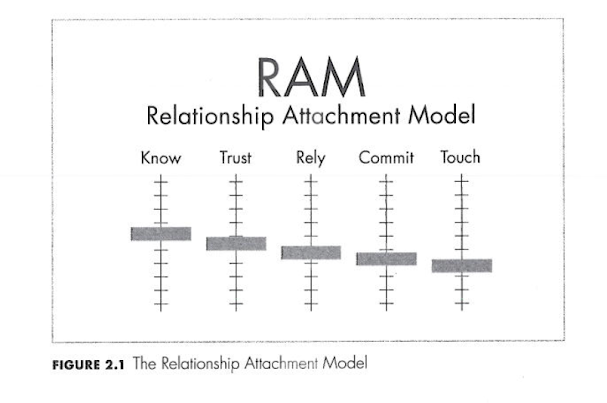Preparing For Marriage with RAM
Have you ever wondered what makes a romantic relationship healthy? Why do people get attached to toxic partners? What does healthy attachment look like?
Here is a picture of the model, which I will be referring to throughout this post:
The Five Aspects of Attachment
How would you define attachment?
According to Van Epp, "Relationship bonds include concepts such as trust, reliance, commitment, affection, emotion, love, needs, and intimacy" (p. 22).
In other words, there are many different components of a relationship and there is a lot to unpack. Some of these are even somewhat hard to define.
However, he goes on to say that these are all a result of what he describes as "five universal human dynamics working together" (p. 22). These are knowing, trusting, relying, committing, and touching.
I will go over each one of these.
1) Know:
This is the extent that you actually know the person. How do you get to know someone? Perhaps the first thing that comes to mind is time. However, I would argue that quality is just as important as quantity.
For example, if you simply sit around watching movies all the time, you really aren't getting to know the person. Sure, you are spending time with them, but you are losing the opportunity to truly discover more about who they are. In this scenario, the other person doesn't have an opportunity to learn about you either.
On the other hand, intentionally planning dates where you will be able to interact and learn about each other is a great option. There is an important difference between going on a date and just "hanging out."
Examples of dates could be sharing an activity that you enjoy, planning a date around one of their interests, having conversation, joining in a team-building activity, serving, doing something more adventurous or stressful, going outdoors, etc. Dates don't need to be expensive. They can be cheap, creative, and fun. Go in with the intention of learning and getting to know the person.
Knowing is the first step.
2) Trust:
According to psychology, one of the number one things men and women look for in a relationship is trust. It is foundational, which is why knowing the person is a precursor to it. How can you trust someone you don't know? Trust is a deep and positive confidence in another person. Mutual trust creates feelings of unity and oneness. The slider for trust on the RAM model rises as there is increased trust.
3) Rely:
Relying naturally follows trusting. You believe they have good intentions and that they will be able to help you in times of need. You feel like you can depend on them. The higher this slider is moved up, the more you feel like you can rely on this person to meet important needs, both physically and emotionally.
4) Commit:
After these three components, you can now choose to commit with a healthy baseline. Without the basis of the three aspects of knowing, trusting, and relying, you run the risk of committing too early to someone who perhaps you don't actually know, someone who actually may not be trustworthy, and someone you may not be able to rely on to help meet your needs. I will dive more into the importance of order and balance later on in this post.
5) Touch:
The slider for touch represents the extent your are physically intimate with someone. Touch is powerful, which is why it is the last slider.
The Importance of Order & Balance
Going back to introduction question, what does healthy attachment look like? The answer is balance. Van Epp explains, "Whenever the relationship dynamics shift out of balance with each other, you will feel unsafe, experiencing feelings of hurt, betrayal, confusion, mistrust, unfairness, anger, loneliness, or any combination of these. But when you keep these five dynamics in balance with each other so that you are not moving further ahead in one area than in any of the others, then you are securely planted in the safe zone" (p. 24).
Another important dynamic Van Epp brings up is that you should "never go further in one bonding area than you have gone in the previous" (p. 25). What he means by this is order matters. Knowing comes before trusting, trusting comes before relying, etc. This is represented by his model. The highest slider is knowing, and then each other slider follows it to a slightly lesser degree. They are all balanced and very close to one another. Again, order matters!
Conclusion
Attachment is complex, but when we break it into these five components, it can be manageable and more understandable. By recognizing where you personal sliders are at in your relationship, you can better navigate it to ensure your attachment is healthy. I highly recommend checking out John Van Epp's work. His book is great! Thanks for reading.

Comments
Post a Comment